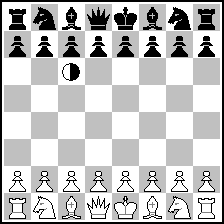|
|
| (1) Posted by Hauke Reddmann [Saturday, Jan 30, 2021 19:29] |
Another CSE question taken over :-)
The game starting position is a h#2 (Fool's Mate) if you
either switch the right to move or the party getting mated
(which makes a bit of sense since it is only convention
that Black starts and is mated. But White begins in chess,
so "shortest mate" and "h#?" are different).
A twin is a) add a piece, b) delete a piece, c) swap two
pieces, d) change identity of a piece (and I possibly forgot
a few lesser ones, e) change stipulation isn't relevant here!).
Twin the game starting position such that...
Puzzle A. It's an unique h#2 (White begins and is mated)
Puzzle B. No h#3 is possible (dito)
Ignore legality questions!
I found only 1 (for fuzzy values of 1) solution for both.
But I didn't try the MORE wacky ideas yet.
|
|
| (2) Posted by Ulrich Voigt [Saturday, Jan 30, 2021 21:57] |
Switch wQd1 with bNb8 for a unique h#2: 1. e5 Qxc7 2. Ke7 Qxe5++
|
|
| (3) Posted by Adrian Storisteanu [Saturday, Jan 30, 2021 23:11] |
Another regular h#2 (black starts, gets mated):
SWAP Sb1 <-> Qd8:
1.Sb8-c6 Sd8-e6 2.Sc6-d8 Se6xc7#
|
|
| (4) Posted by Adrian Storisteanu [Saturday, Jan 30, 2021 23:21] |
Interestingly, two possibilities for a correct, regular h#1.5 (white starts, mates):
SWAP Ra1/h1 <-> Bc8:
1...Rc8xc7 2.Qd8-c8 Rc7xc8#
SWAP Pc2 <-> Ph7:
1...Qd1xc2 2.f7-f6 Qc2-g6#
|
|
| (5) Posted by Adrian Storisteanu [Sunday, Jan 31, 2021 00:28] |
Finally, off topic (maybe for an extra credit!?), but had to try it, a series helpmate in 3 (ser-h#3):
SWAP Ra1/h1 <-> Ra8:
1.d7-d5 2.Qd8-d6 3.Sb8-d7 Ra8xc8#
|
|
| (6) Posted by Ulrich Voigt [Sunday, Jan 31, 2021 00:57] |
Swap wNg1 <--> bKe8 and there is no h#3.
|
|
| (7) Posted by Peter Wong [Sunday, Jan 31, 2021 01:04] |
http://www.matplus.net/start.php?px=1612051405&app=forum&act=posts&fid=prom&tid=2113
|
|
| (8) Posted by Sarah Hornecker [Sunday, Jan 31, 2021 05:06] |
Only dual free if pawn double steps aren't allowed (unless I missed other solutions).
Ng1-Ng8 swap, h#2, duplex
1.Nxe2 Qxe2 2.g6 Nf6 mate
1.Nxe7 Qxe7 2.g3 Nf3 mate
(Found by Theodoros Glakatis in the old thread.)
QUOTE
(2) Posted by Theodoros Giakatis [Monday, Jan 1, 2018 21:10]; edited by Theodoros Giakatis [18-01-01]
Happy New Year!!
If I understand the definition correctly, a solution can be:
Changing the position between the White and Black Knights on g1 and g8 can lead to the following
1.Ne7 Qe7 2.g3(g4) Nf3 #.
If someone has played some Caro-Kann games it's easy for him to imagine this image of mate.
Theo
|
|
| (9) Posted by Joost de Heer [Sunday, Jan 31, 2021 10:26] |
Solution for a)
Zóltan Laborczy, after John Niemann
Problemesis 2004
 (= 16+16+1N ) (= 16+16+1N )
(Imitator c6)
a) h#3
b) Ic6->g6, h#3 2.1.1...
c) Ic6-e4, h#3
d) Ic6->d7, h#3
e) Ic6->d8, h#4
f) Ic6->b2, h#2.5
g) Ic6->b1, h#2.5
|
|
| (10) Posted by Hauke Reddmann [Sunday, Jan 31, 2021 12:50] |
Oh, I already posted (half of) it? So much for my
computer memory...
My own solutions were
a) Ph7->b3 or d3 (C+) (i.e. essentially Adrian's)
b) swap Bf8 with any White "heavy" (C+) (i.e.
an addition to Ulrich's)
|
|
No more posts |
MatPlus.Net  Forum Forum  General General  Another CSE question taken over :-) Another CSE question taken over :-) |
 ISC 2024
ISC 2024 Forum
Forum  General
General  Another CSE question taken over :-)
Another CSE question taken over :-) 


